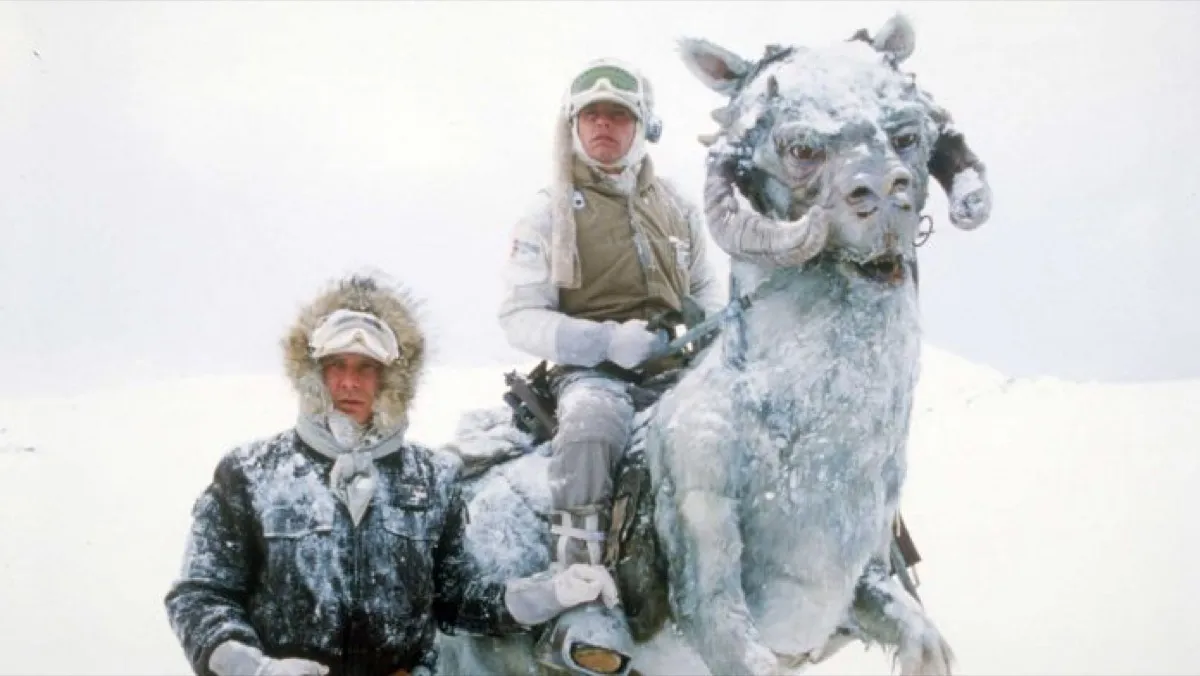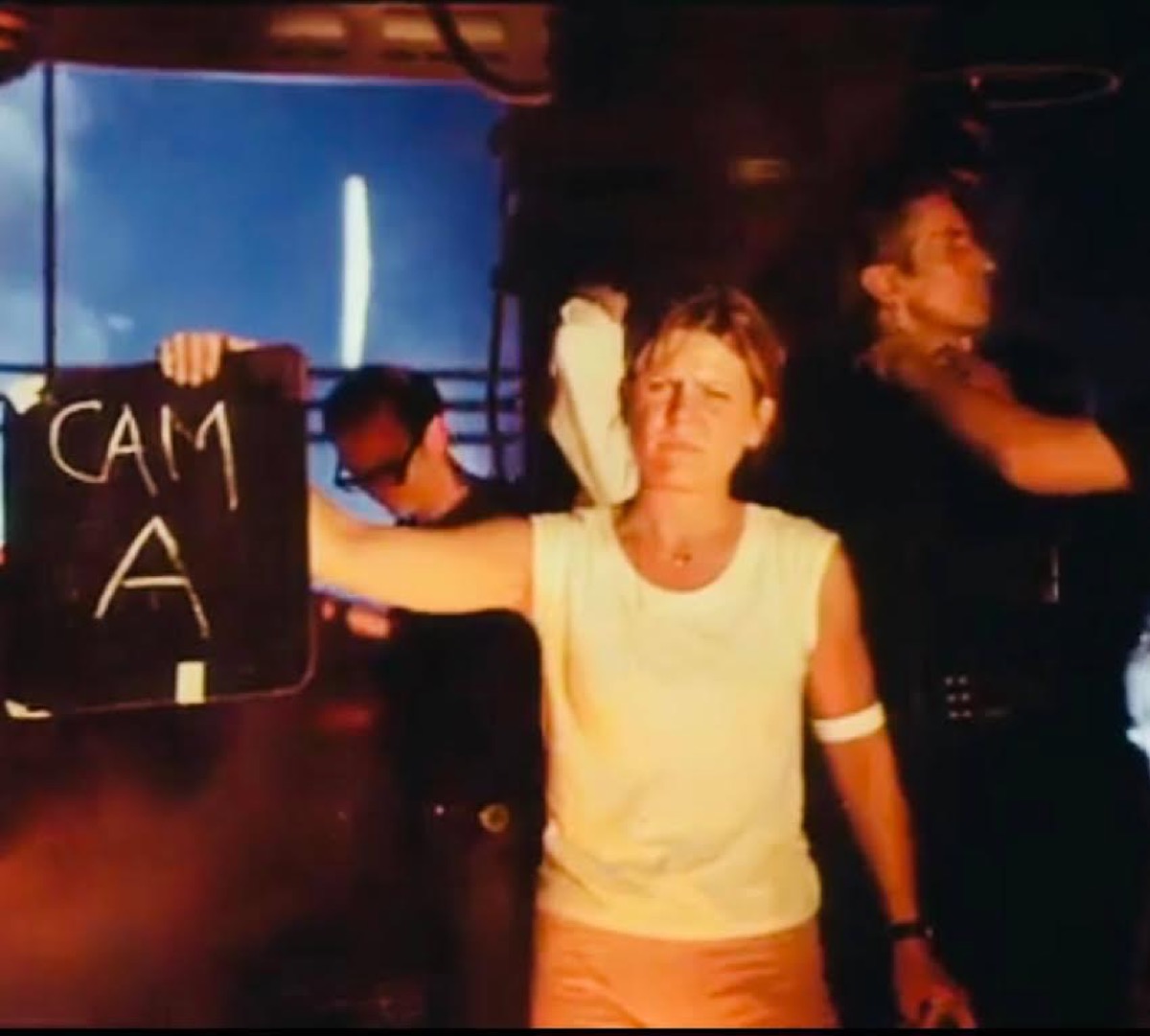I Went to Hoth to Go Behind the Scenes of The Empire Strikes Back at 40
I talked to the crew about the shoot, women working on the set, and of course, Carrie Fisher.
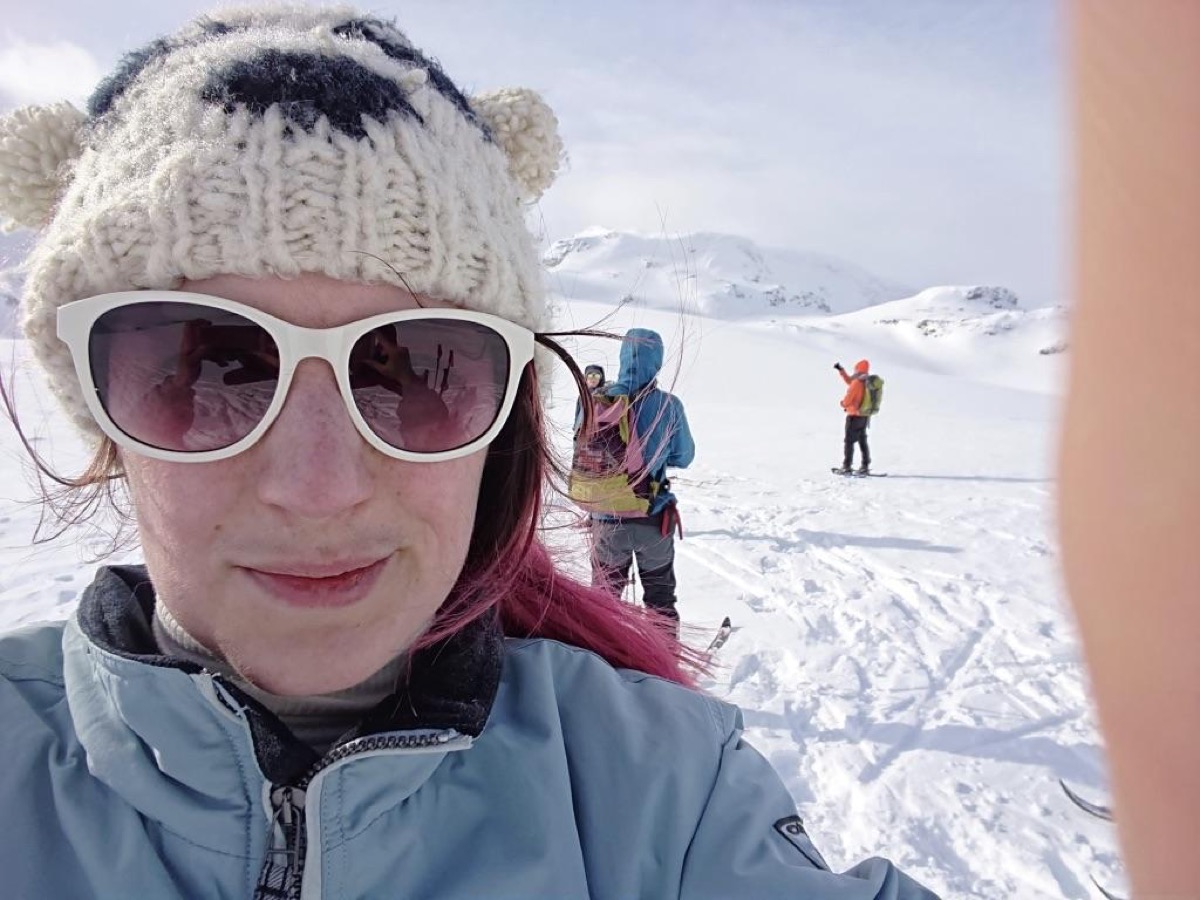
There’s a thick bloom of condensation tracking across my sunglasses, and I can’t see out of my left eye. A ferocious wind blasts across the rocks with such force that I slide backward down the incline. Panicking, I dig my unwieldy cross-country skis—I’ve never used them before—into the powdery snow and hope that when I fall it doesn’t hurt.
My foolhardy inexperience has brought me this far, but now I’m anxious, and after a ninety-minute trek across a frozen lake and up one of Norway’s tallest glaciers, I’m not sure that I’ll make it to the end. Fortunately, my very kind companions are there to encourage me onward. It’s astonishing, I think, as we near the peak, how far Star Wars fans will go to celebrate the films they love.
Because this isn’t an ordinary winter sports expedition. I’ve been invited to the remote Norwegian hamlet of Finse to retrace the footsteps of Carrie Fisher, Harrison Ford, and the film crew based at the Antarctic training spot during the spring of 1979 while shooting scenes for The Empire Strikes Back. Travel to the annual Visit Hoth festival, which celebrates all things Star Wars, is not easy.
Finse is only accessible by train (when people say there’s nothing there aside from a station, a hotel, and a local shop, they mean it), and the week before my arrival, there’s an avalanche blocking the tracks. Harrison Ford himself was stranded by heavy snow en route to meet his castmates, and the shoot was a nightmare of bad weather and mechanical mishaps.
Your tauntaun will freeze before you reach the first marker
Everyone who’s seen The Empire Strikes Back will recognize ice planet Hoth. It’s where Luke battles the wampa, where Han makes a camp inside a tauntaun, and where Darth Vader’s Imperial forces attack the Rebels at Echo Base.
Stories about the location shoot are legendary: In the hostile conditions of ‘79, amid one of Norway’s worst winters on record, there was barely time between breaks in the cloud to shoot. Celluloid film snapped in the cold; trenches dug by the crew for the Rebel fighters filled every night with fresh snow.
Even in the bad (but by no means extreme) weather of my experience, it’s easy to understand how exhausting life at Finse was for the cast and crew.
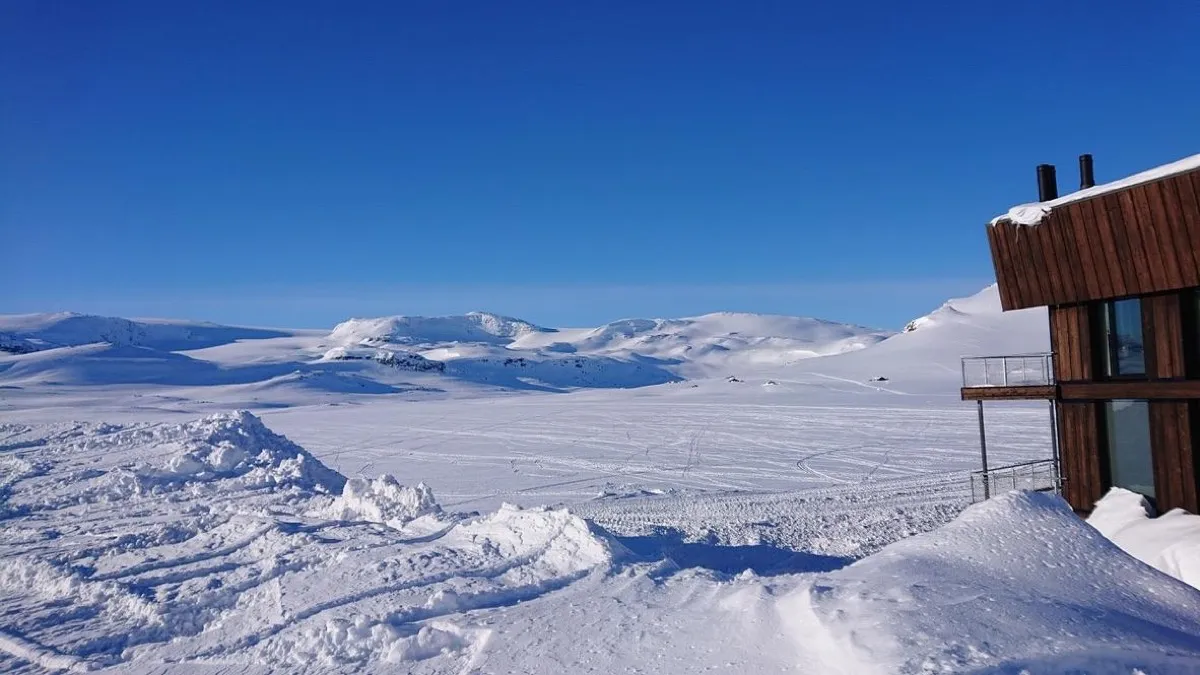
Hotel Finse 1222 sits on the edge of a frozen lake across from the glacier (far left) where the Imperial AT-ATs attacked the Rebel fleet in The Empire Strikes Back. (Rebecca Harrison)
On-hand to give us the inside story about the treacherous conditions are second-unit director Peter MacDonald (whose credits include Cabaret, Batman, and many of the Harry Potter movies) and assistant cameraman Michael Brewster (Monty Python’s Life of Brian, The Muppet Christmas Carol, Harry Potter). Additionally, celebrating the film’s fortieth anniversary and the contributions of women to the franchise, there’s a guest appearance from Madelyn Most (Pressure, Star Wars: A New Hope), the only woman in the camera department at Elstree.
Most of the crew, MacDonald and Brewster tell me, had no experience shooting in extreme cold weather. The crew worked in special tents and set up a facility in the hotel basement where equipment was stored at -1 degree Celsius to prevent damage caused by moving between indoor and outdoor temperatures. Technology also had to be “winterized,” and the Vista Vision camera that they used to capture images for the special effects team was filled with anti-freeze oil and given a special heated hood.
Referred to by the pair as “George’s camera” (it was sent to Norway by Lucas himself), a mishap with a skidoo sent a crate of equipment tumbling down the glacier and nearly destroyed the camera midway through the shoot. Luckily for them, it lived to photograph another day.
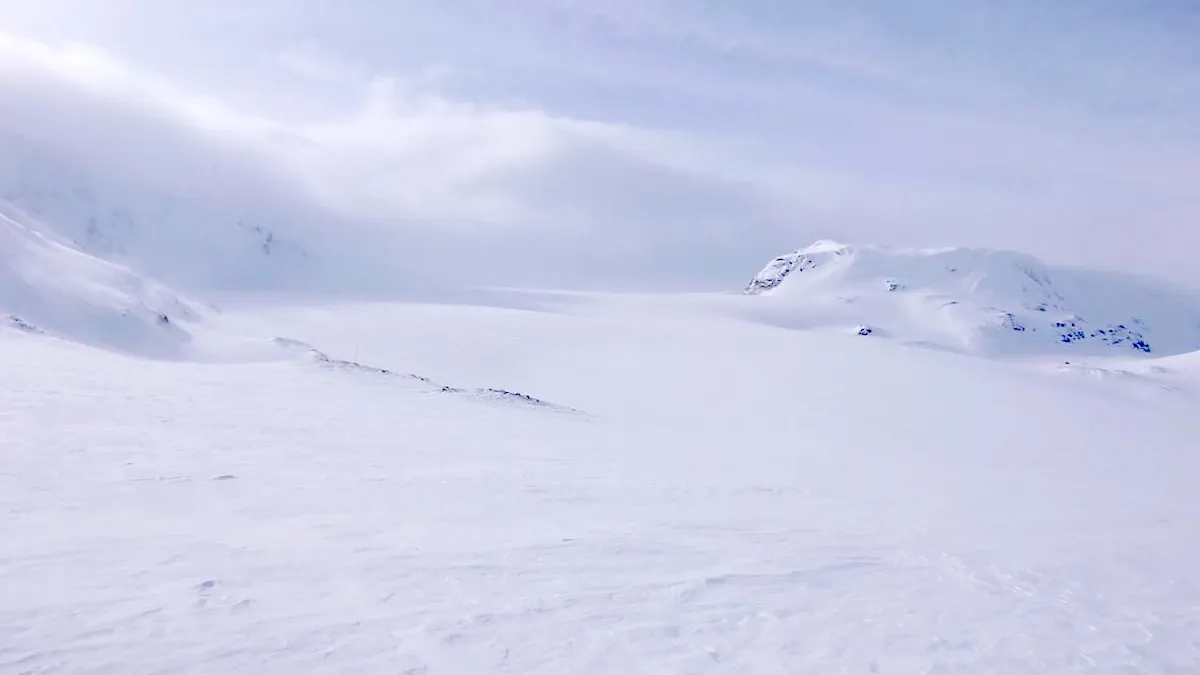
A snowstorm rolls in suddenly across the ridge of the glacier, reducing visibility in the whiteout. (Rebecca Harrison)
The environment had a huge impact on the crew members, too: Amid the near-constant snowstorms, they were separated from friends and family for weeks at a time and worked fifteen-hour days in the cold. On my glacier hike, I spend just five hours outside on a day that started out fine (brilliant sunshine, temperatures of around -19), and there are spectacular views of untouched snow and mountain vistas that look like peaks of perfect meringue.
But it is physically grueling and ends with a whiteout; with no shadows to break up the endless monotony, my depth perception disappears. The hotel on the horizon could be 100metres or 10 miles away, and by the time I return for my husky trip to “Han’s Rock,” I’m dead on my feet.
Yet, despite all the hardships, MacDonald recalls a team that was bound together by camaraderie—the camera unit, he says, had a “military” quality to it that kept everyone safe and left no one behind.

A husky-sled ride takes me to “Han’s Rock,” a local landmark known for its appearance in The Empire Strikes Back. (Rebecca Harrison)
I wonder how the shoot compared to other films that the crew worked on. “If you’re in the studio, that’s absolutely fine,” MacDonald tells me. “You can plan everything. But when you’re in an outside environment like this one, it’s quite hostile … You have to change with the weather. So, sometimes we went outside when the weather is like it is today—blizzards—and you have to cut what you’re able to manage in that time. When it’s nice, you go and do the call sheet.”
Of course, with its innovative use of visual effects including matte backgrounds and animated models, Empire was a complex shoot. The crew at Finse had no idea what their photography would look like after it had been through post-production. Brewster recalls being amazed by the AT-ATs and other special effects in the theatrical cut of the movie. “It was wonderful,” he says.
Don’t call me your highness
In keeping with 2020’s Visit Hoth theme, “Women in The Empire Strikes Back,” both men sing the praises of Pamela Mann, the only woman on the crew based at Finse. Mann was the “continuity girl,” which was a thankless task under such difficult conditions. But MacDonald describes how she would remember everything mentally and with precision. Like most continuity girls (a position more common in the British film industry than in Hollywood), she was, says Brewster, “formidable.” I get the sense that despite their greater numbers and power on shoots, none of the men tried to argue with Mann more than once.
Back in England at Elstree Studios, Madelyn Most was similarly outnumbered on both Star Wars and Empire. ‘There were three or four of us on the first film. On the second one I don’t remember many. We just found a way to be accepted,” she recalls.
Working as a camera assistant, her job involved a lot of heavy lifting—and a lot of climbing ladders in the vast studio. “I was very nervous but the same time I was like right, I’m gunna be tough, like macho man. And then the men, before they knew me, said, ‘Oh you’re going to be so unfeminine; you’re going to get muscles in your arms.’ I said women in America pay to do that! They pay to go to the gym. Once I’d done that, and brushed them off, they liked me—and I dressed very boyish, I put my hair back, I wore man’s clothes. I earned a reputation for not being treated feminine.”
We spend an afternoon discussing her career (she continues to work as a documentarist interested in social justice) and her recollections of the Empire shoot. “Elstree was huge, like an airplane hangar,” she reminisces. “I didn’t know what was going on … I had no idea what Star Wars was. I mean, it could have been two actors in a room! But suddenly it was this huge, big thing. And I thought, well, this is really cool, and I was really proud—dazzled. I had to pinch myself and hope not to screw up.” Her job as second assistant cameraman (there’s no separate designation for camerawomen in the credits) involved recording log sheets, loading magazines of film, and checking there was enough of the film roll left for each shot.
Having read about how challenging the Rebel Base and Dagobah swamp sets were to work on, I ask Most how she felt about them. The Rebel Base, she says, was covered in “shellac stuff so that the walls were glistening like snow. They kept spraying them down with these aerosols, and then we had dulling sprays, and in the lights, that’s like a brew that heats them up. There are fumes, and it’s hot and sticky and affects your clothes and you get all grimy.”
In the Bespin carbon-freezing scenes, she had to acclimate the camera lenses to the steam. And the swamp? ‘The swamp was really bad—it was tense, really tense. Like ‘Get me out of here!’ It was a real swamp, and it was slippery. You could fall! I think everything was going bad for Kersh [Irvin Kershner, the director], and Mark [Hamill] was unhappy about stuff. It was really difficult.”
But for the most part, Most still speaks with excitement and enthusiasm for Star Wars. “You knew everything was going to be engrained in your memory for life, it was so huge,” she remembers, smiling. “Everyone was happy and getting along.”
In particular, she struck up a friendship with one of the stars: Carrie Fisher. It all started when Most was carrying camera magazines backstage in the early morning: “I could hear Joni Mitchell. And I was just like a magnet. I was thinking, where is this music coming from?” Investigating the source of the singing, Most came across Fisher in hair and makeup.
‘They were putting on her big bagels, and I said, ‘Oh, I love Joni Mitchell, you’re playing Joni Mitchell!’ She said, ‘I love her, too,’ and that’s how we became friends. We had a lot in common.” The pair would take walks around Hampstead Heath by day, and enjoy themselves at post-shoot parties, too. “I was partying with Carrie all night,” she laughs.
And she’s under no illusion about how Fisher would respond to politics in 2020: “The Force is to make a better world; it teaches people integrity. People are supposed to be Rebels. If Carrie was alive today, she’d be leading the revolution. She really would.”
My time at Finse is nearly up. Wrapping up her thoughts about the Star Wars experience, it was a positive one, Most concludes. “I was like a kid in a candy store. I thought it was marvelous.” Sitting in the same hotel that was home to my childhood heroes and hearing from the crew who brought The Empire Strikes Back to life through blizzards and avalanches, I know the feeling. It’s film tourism so extreme that you definitely don’t want anyone to tell you the odds.
But when I reach the top of that glacier ridge on my unfamiliar skis, my spirits soar into the vast expanse of blue sky. It’s soul-crushingly cold, and the fingers inside my gloves are numb. No matter. Finally, we’ve reached the peak, and we stand about to laugh and take photos. There, right below us, is the location of the AT-AT battle on Hoth. As Star Wars fans, we’re on top of the world. It really is marvelous.

I stand at the highest point of our trek up the glacier alongside fellow Star Wars fans. (Rebecca Harrison)
(featured image: Disney/Lucasfilm)
Rebecca Harrison’s Visit Hoth trip (March 2020) was sponsored by, among others, Hotel Finse 1222, Visit Hoth, the Nordic Film Tourism Association, and Vy Group.
Want more stories like this? Become a subscriber and support the site!
—The Mary Sue has a strict comment policy that forbids, but is not limited to, personal insults toward anyone, hate speech, and trolling.—
Have a tip we should know? [email protected]
